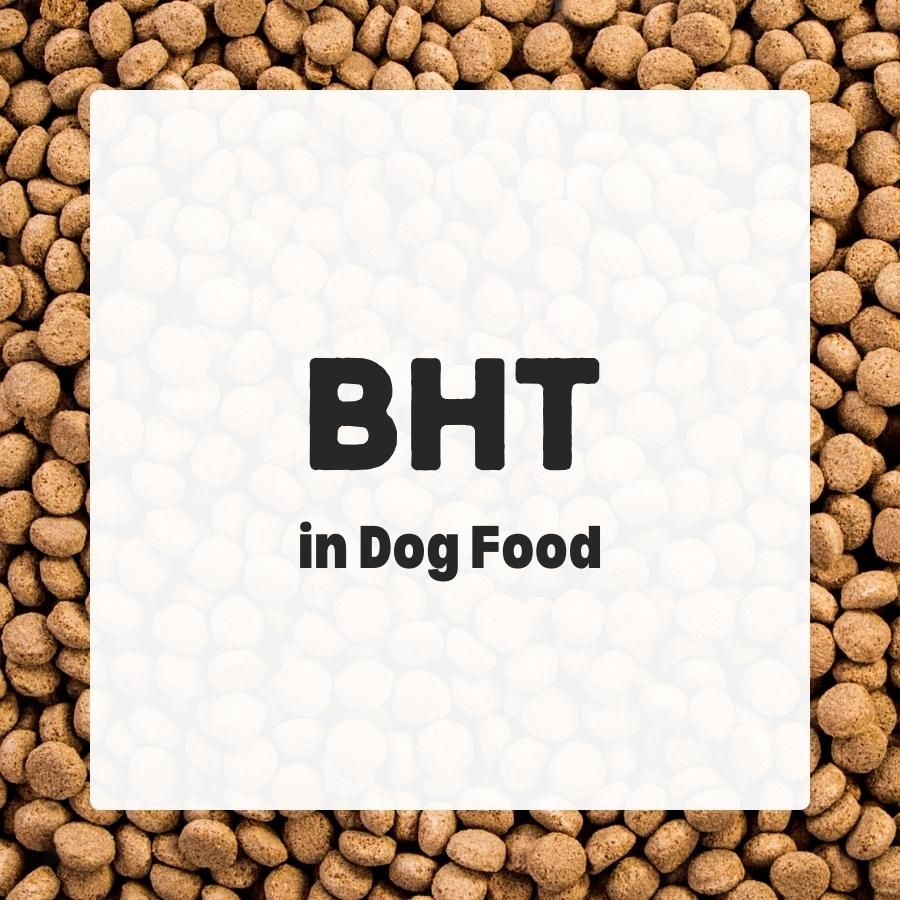BHT in dog food is a food additive used as a chemical preservative due to its antioxidative properties. It’s a controversial ingredient linked to potential safety risks.
Contents
What is BHT?
BHT or Butylated HydroxyToluene is an artificially produced chemical preservative commonly used as a food additive.
It may not be exactly what comes to mind if you about natural ingredients. But interestingly, some microorganisms as well as the fruit lychee produce BHT as an antioxidant!
As a potent antioxidant, BHT is a white powder that can maintain the freshness, texture, color, or flavor of dog food.
It prevents spoilage and extends the shelf-life of both human and animal food and is also used in cosmetics and pharmaceuticals.
BHT in Dog Foods
In the United States, BHT is approved as a food additive for concentrations up to 0.02% by weight of a food’s fat or oil content.
In the European Union, BHT is authorized as a food additive for dogs (E 321). It can be used at concentrations up to 150 mg of kg complete feed (alone or in a mixture BHA).
It’s not only used directly in dog food or dog treats.
On many occasions, animal fat or other raw materials gets treated with BHT or BHA and is then used as dog food ingredients. And it’s also found in other fatty ingredients like fish or fish meal.
And it can even be applied to food packaging, too!
In 2022, researchers have detected the presence of at least one chemical preservative such as BHT, BHA, TBHQ, or ethoxyquin in almost all samples of dog food tested[6].
Is BHT Bad For Dogs?
The FDA thinks BHT is generally recognized as safe[5].
The European Food Safety Authority (EFSA) evaluated the safety of BHT when used as a feed additive for animals[1].
They concluded that BHT in dog food did not cause any adverse effects as long as it is used in small amounts.
However, EFSA also pointed out that high doses of BHT can have a negative impact on the liver health of some animals and affect their growth and development.
BHT is also thought to have tumor-promoting activity and maybe act as an endocrine disruptor. At the same time, it may also have some antiviral and anticancer properties[2,3,4,8,9].
Manufacturers can choose to use BHT for dog food products, but only at the low levels approved by regulatory authorities.
Overall, BHT doesn’t seem as bad as his cousin BHA. But it’s probably still not something you want to feed your dog every day all his life. So we recommend avoiding BHT when possible.
Further Reading
[1] FEEDAP Panel. Safety and efficacy of a feed additive consisting of butylated hydroxytoluene (BHT) for all animal species (Katyon Technologies Limited). EFSA Journal. 2022. https://doi.org/10.2903/j.efsa.2022.7287
[2] Babich. Butylated hydroxytoluene (BHT): a review. Environmental Research. 1982. https://doi.org/10.1016/0013-9351(82)90002-0
[3] Kahl. Synthetic antioxidants: Biochemical actions and interference with radiation, toxic compounds, chemical mutagens and chemical carcinogens. Toxicology. 1984. https://doi.org/10.1016/0300-483X(84)90038-6
[4] Williams et al. Safety Assessment of Butylated Hydroxyanisole and Butylated Hydroxytoluene as Antioxidant Food Additives. Food and Chemical Toxicology. 1999.
[5] CFR § 582.3173 Butylated hydroxytoluene.
[6] Costa et al. Concentration of synthetic antioxidants and peroxide value of commercial dry pet foods. Animal Feed Science and Technology. 2022. https://doi.org/10.1016/j.anifeedsci.2022.115499
[7] Lundebye et al. Levels of synthetic antioxidants (ethoxyquin, butylated hydroxytoluene and butylated hydroxyanisole) in fish feed and commercially farmed fish. Food Addit Contam Part A Chem Anal Control Expo Risk Assess. 2010. https://doi.org/10.1080/19440049.2010.508195
[8] NTP (National Toxicology Program). 2021. Testing Status of Butylated hydroxytoluene. U.S. Department of Health and Human Services. https://ntp.niehs.nih.gov/go/ts-10575-k
[9] Kahl & Kappus. Toxikologie der synthetischen Antioxidantien BHA und BHT im Vergleich mit dem natürlichen Antioxidans Vitamin E. Z Lebensm Unters Forch. 1993. https://doi.org/10.1007/BF01197931
